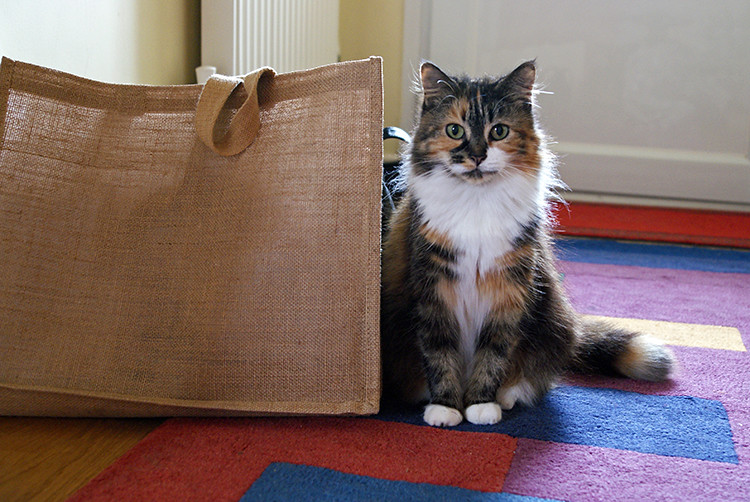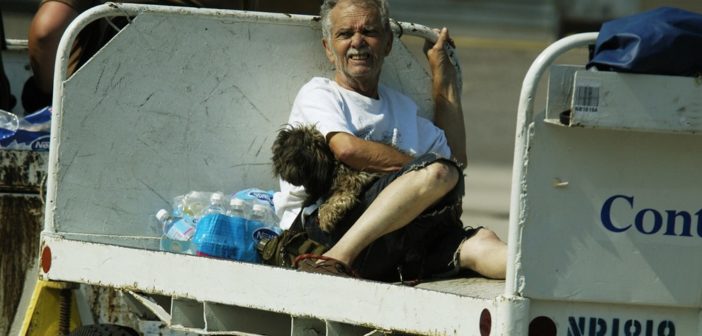Fires, floods, hurricanes and blizzards can be extremely dangerous to both humans and animals alike. Disasters can strike in any place, at any time, and often there is little or no warning.
Most government agencies, such as the Federal Emergency Management Agency (FEMA), strongly encourage each household to have a predetermined emergency plan (and an emergency bag for every member of the family) in case of an evacuation from their home, neighborhood, town or city.
The following guide can help you organize your family’s disaster preparedness plan. Your pets should be a part of this plan.
What can you prepare? Planning is key!
Taking measures to protect your animals ahead of time could help save lives!
Your disaster plan includes knowing what specific disasters may affect your area and how you will react to them. This means predetermining how you will get out in case of an evacuation, where you would go, or who you would meet.
Your disaster preparedness plan should include all members of your family and household. Make sure they all know the plan. You may never know who will be home to safely pack your pets for an evacuation.
Ask yourself these questions to see how prepared you are:
- Do you know how to get information before, during and in the aftermath of an emergency?
- What local, national and international agencies should you be checking for up-to-date news?
- Is there an animal charity in your area that works with any of these agencies on disaster preparedness and response?
- Do you have a list of official and personal emergency contacts?
What you can do before disaster strikes?
Make sure that you have the following:
ID tag. If you are forced to leave your dog or cat during an evacuation, you should place a collar with an identification tag on your pet to ensure they can be quickly identified. Make sure that your pets are also microchipped and registered and all their details are up to date. This ensures that you and your pets can be reunited after the disaster if you are separated.
Emergency card. One very simple measure is to put an emergency card (often in the form of a decal or sticker) in a visible place, such as by the front door of your house or apartment. This card holds important information like the species, names, and the number of pets in the household. When disaster relief rescue teams come to your home, an emergency card will help them quickly assess what animals need to be rescued, even if you are not at home. It’s also very important to keep the pet information on the emergency card/sticker up-to-date to help ensure the safety of the rescue teams as well as your pets.
Pet disaster kit(s). In most disaster situations it will be difficult to get pet food, clean water, and any medications for your pets’ medical needs, so the first step is to make a “disaster kit” or a “go bag” for your pet. In your kit, include supplies for staying at home and for evacuations.

This should include:
- Food and water for at least five days, food bowls, a blanket, trash bags to collect your pets’ waste, a sturdy collar, harness, and leash. If your animal uses medication, make sure you store a supply of medication as well.
- Up-to-date contact list including: veterinarians (your local vet and two vets in opposite directions up to 50 miles away), friends or family you could stay with if you evacuate, pet-friendly evacuation centers or hotels, animal shelters or boarding facilities that could look after your pet, and local rescue and emergency authorities.
- Documents such as copies of your pet’s identification papers and medical records should be kept in a waterproof protective cover in the kit.
- Your kit should be stored in an easy-to-carry box in a safe and dry place.
Your disaster plan and kit will help you in determining how you will get out in case of an evacuation (which type of transportation, car, train, etc. and if they allow pets), and where you would go and meet (making sure again that these places, whether a hotel or a relative’s home, do accept and have room for your pets).
Lastly, it is important to make sure that all family and household members know the plan. Leaving a clear plan in place is the most effective way to securing the survival and safety of each member of your family, pets included.
Additional advice would be to know your pets’ hiding places so you can easily find them in an emergency. Practice evacuating quickly and calmly, and taking shelter at home away from doors and windows. Practicing will help your pet get used to the routine and will reduce their stress should a disaster occur.
What if you are not at home?
If you are out of the house when a disaster strikes, you may not be able to return to your home and your pet. Make arrangements with neighbors or friends ahead of time to care for your pets. Be sure:

- Your pets have met the person.
- The person has a key to your home.
- The person knows where your pet emergency kits are kept and is able to properly use the kit to care for the animal for a short time period.
- The person knows where to take your pet in the event of evacuation and is able to do this if needed.
Find out what resources you already have. Ask yourself these questions:
- What can you do to prepare your home to minimize damage from the most common types of disaster in your area?
- If you are told to stay where you are, what do you need to prepare so that you and your pets can stay safely indoors?
- Do you have somewhere to go if you need to evacuate?
- If so, can your pets stay there with you?
- If not, do you have friends or family who could take care of your pets for you?
- What if you are at work when the disaster strikes?
- Who can get into your house?
- Who is familiar with your animals?
- Do you have a plan to reunite with your pets in this case?
- What if you have to leave your pets behind?
- How will people know you have animals in your home?
- If kept outdoors, are your pets free to move to higher ground?
- What supplies do you have ready for you and your pet in case of an emergency?
- Do you have any unusual pets such as birds, reptiles and small mammals (e.g. rabbits, mice, gerbils, etc.)? These animals may not be accepted in places that take dogs and cats and may need other specialized supplies.
- Where will you take them?
- What supplies do you need for these special pets?
What you can do when disaster is imminent?
In an actual disaster, listen to warnings and instructions from the authorities on evacuating or remaining in place. Follow these instructions. Do not stay behind if you are told to evacuate. If the recommendation is made to evacuate, it is best not to wait until the last minute to leave with your pets. If your home is not affected by the disaster, you can always go back. But if you are slow to leave, you may be forced to leave pets behind if emergency rescue teams need to evacuate you.
If you are staying at home during the disaster, are you prepared to care for yourself and your pets with no access to running water or power?
What you can do in the aftermath of a disaster
It may be some time before you can return home. Do you have sufficient supplies for your pets, particularly of prescription medications? If not, can you reach your veterinarian or do you have copies of your pets’ prescriptions? What about special diets or other medical needs? Once you are home or, if you have stayed at home, once it is safe to venture out, there are other considerations for your pets’ health and safety:
- What will you need to do to make sure the house is safe for your pet? Debris, water-logged items, etc. may pose a health or safety hazard.
- What about the garden? What dangers are there?
- What other changes may affect your pet after a disaster? Think about sights, sounds and smells in and around your home that may be very different, causing disorientation.
- Was your pet distressed during the disaster or evacuation? What can you do to help him/her readjust?
FOUR PAWS in disasters
FOUR PAWS has dispatched emergency response and disaster relief teams to many areas around the world to help animals in need after natural disasters. We provide food, medical care and our expertise to help rescue and care for animals and reunite pets with their families.
It is from this experience that we know that nothing can replace preparedness. Each one of us has the power to plan ahead of time, ensuring the safety of our family and pets.
Featured image: a man and his dog are evacuated during Hurricane Katrina. Image credit Liz Roll / FEMA Photo 14751, CC BY-SA 2.0.





